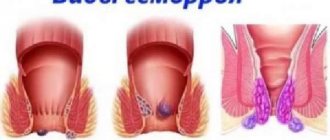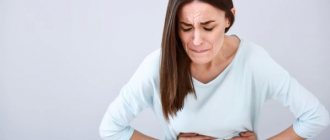According to medical statistics, postpartum hemorrhoids
is a problem faced by 50% of women who have had a natural birth.
The pathological condition is characterized by varicose veins in the area of the hemorrhoidal plexus in the early postpartum period. Its initiating factor is stagnation, which provokes stretching and deformation of blood vessels, which is why the latter take the form of nodules or bumps of various diameters. The main difficulty in the treatment of postpartum hemorrhoids
is that it has to be carried out during lactation, and this imposes a number of restrictions and requires careful selection of pharmacological drugs.
Causes of hemorrhoids after childbirth
The initiating factors leading to the development of hemorrhoids during pregnancy and after it are pathological changes in the blood vessels of the veins located in the area of the hemorrhoidal plexus. The following factors have a direct impact on the development of the disease:
| Factor | What is the reason? How does it manifest? |
| Hormone progesterone | The progestogen sex hormone affects the tone of smooth muscle tissue fibers downward and loosens connective tissue. Because of this, disturbances in the outflow and deposition of blood occur, and cavernous bodies appear. |
| Obstetrics | The stress during childbirth is quite intense and leads to an increase in pressure inside the peritoneum. When the baby's head descends into the pelvis, compression of the veins of the rectum occurs, and its weakened areas bulge. When the head comes out, an existing hemorrhoid may be displaced outward and even the nodes may rupture. |
| Blood stagnation | As the fetus develops, the level of intra-abdominal pressure increases, causing disturbances in the outflow of blood. This happens because the uterus puts pressure on the inferior vena cava, causing blood to stagnate in the area of the hemorrhoidal plexus. As a result of the latter, the vessels dilate. |
| Sedentary lifestyle | Refusal of any physical activity during pregnancy is an unsuccessful decision, due to which intestinal motility decreases and regular constipation appears, which worsens the situation. The fact is that when straining, intra-abdominal pressure becomes even higher, which will result in the need for treatment of postpartum hemorrhoids during breastfeeding . |
What are hemorrhoids?
First, let's figure out what postpartum hemorrhoids are. Hemorrhoids are varicose veins that cause blood to accumulate and stagnate, making the vein look like lumps or nodules. These enlargements appear in the rectal area and can range from the size of a pea to the size of a grape. They can be found inside the anal part of the intestine (internal hemorrhoids) and outside the anus, under its skin (external). Depending on the severity of the disease, a person may simply feel itching, or, in another case, severe pain and discomfort accompanied by bleeding.
Picture of the disease in various stages
Based on the severity of symptoms, the following stages of the disease are determined:
- I – Almost asymptomatic. The nodules are small and do not make themselves felt until there is a need for bowel movements. After stool, you may experience itching, discomfort, or incomplete emptying. Bloody discharge is rare.
- II – Previously invisible nodes may appear outward from the anus when straining. During relaxation, they come back on their own. Itching, burning, and inflammation of the anal area intensify. Rectal bleeding often occurs after using the toilet or heavy physical work.
- III – Knots can fall out for no reason, at the slightest tension of the press. You can only straighten it with your hands. The pain at this stage is constant, bleeding becomes profuse, since large nodes are often injured.
- IV – Huge knots constantly fall out, they are not easy to straighten even with your hands. Exacerbations in the form of thrombosis and necrosis of cones often occur. Requires surgery.
Unfortunately, if a woman had hemorrhoids before pregnancy, there is a high probability that the symptoms will return and worsen after childbirth.
Clinical manifestations of postpartum hemorrhoids
The symptoms of hemorrhoids after childbirth are determined by the stage of its development:
| Hemorrhoid stage | Clinical manifestations characteristic of it |
| First |
|
| Second |
|
| Third |
|
| Fourth |
|
How to cure hemorrhoids for a young mother?
Hemorrhoids in the initial stages of development respond well to treatment. The first thing the doctor will advise you to do is normalize your diet. The therapeutic diet consists of consuming plenty of fiber and limiting foods that can cause constipation. It is equally important to maintain a drinking regime, drinking 1.5-2 liters of clean water without gas daily.
Therapy for hemorrhoids after childbirth is based on the use of medications that do not contain harmful components that can harm the body of a woman or child if he is breastfed.
Depending on the stage of advanced disease, the doctor may prescribe medications:
- anti-inflammatory;
- venotonic;
- painkillers;
- hemostatic;
- anticoagulants.
Sometimes proctologists prescribe a laxative. Such drugs cannot lead to constipation in the future, but will only simplify the solution to the problem.
Additionally, local agents are prescribed (creams, gels, ointments), which relieve discomfort and accelerate the wound healing process. In advanced cases, when conservative therapy is not effective, surgical removal of the nodes or their ligation is performed.
Treatment tactics are determined by the doctor individually after examining the patient. At the same time, he takes into account the degree of development of the pathology, the reasons that provoked it, and the individual characteristics of the woman’s health.
Diagnosis of postpartum hemorrhoids
Before deciding how to treat postpartum hemorrhoids for a nursing mother
, the proctologist conducts diagnostic studies aimed at identifying the characteristics of their development. The process involves:
- Palpation, which reveals changes in relief and the presence of formations with a wide stalk and a smooth surface;
- Anoscopy, which reveals existing disorders and allows one to determine their diameter, structure and location;
- Sigmoidoscopy, supplementing the information obtained during anoscopy and clarifying the diagnosis;
- General blood analysis.
Hemorrhoids must be differentiated from anal fissures, polyps, and rectal neoplasms of malignant etiology.
How is the diagnosis carried out?
When the first signs of hemorrhoids appear, you need to be examined by a proctologist. The doctor will determine external hemorrhoids immediately after a visual examination and palpation of the rectum. To assess whether there is internal pathology, examination with a rectal speculum and other instrumental techniques are used:
- anoscopy - examination of the walls of the rectum using a special device. Its tip is inserted into the anal canal approximately 8 cm. This allows for a detailed examination of the tissue, determining pathological changes in the mucous membrane and venous bases.
- sigmoidoscopy - the examination takes place using a device that fills the rectum with air and allows for good visualization of the intestinal walls.
The appearance of pain during the examination already indicates the presence of pathology. If the pain is severe, the doctor performs an examination under local anesthesia.
How to treat postpartum hemorrhoids?
The question of how to get rid of postpartum hemorrhoids
, is relevant for many women. Treatment tactics are selected individually, taking into account the diagnostic results and the severity of symptoms. The restrictions imposed by the lactation period must be taken into account. Self-medication in this case is unacceptable, since it can cause serious harm to the health of mother and baby.
An integrated approach is justified, including:
- individual selection of a diet that excludes stool disorders;
- regular implementation of hygiene measures;
- performing special exercises;
- warm sitz baths with decoctions of plants that have an astringent effect;
- taking medications.
The latter allow you to eliminate pain, itching, swelling and eliminate tissue infection. Taking phlebotonics has a positive effect on the muscle tone of smooth muscles, strengthens the walls of blood vessels and restores blood microcirculation, due to which the nodes gradually decrease in diameter. If the patient experiences bleeding, she is prescribed anticoagulants, which stimulate the resorption of blood clots and eliminate the risk of new ones forming.
Surgical intervention is practiced in the presence of the following indications:
- Frequent exacerbations of hemorrhoids;
- Loss of nodes;
- Severe pain symptoms.
Removal is carried out using the following methods:
- Latex ligation, which involves placing a latex ligature on the hemorrhoid stem. It squeezes the blood vessels that feed it, and it dies;
- Radio wave excision, aimed at radical removal using high-frequency radio waves and coagulation of blood vessels. Suitable for external hemorrhoids;
- Photocoagulation, which uses a focused infrared beam to cauterize and initiate disruption of the blood supply to the node and its atrophy;
- Desarterization, aimed at suturing and ligating the arteries feeding hemorrhoids.
Hemorrhoids in pregnant women and the postpartum period
Hemorrhoids are a pathological enlargement of hemorrhoids, accompanied by their prolapse from the anal canal, inflammation and periodic bleeding.
Hemorrhoids are one of the most common diseases in the 21st century, which is due to the sedentary lifestyle of modern people, consuming insufficient fiber and large amounts of high-calorie foods, spending a long time on the toilet, etc.
There are external hemorrhoids, formed from the lower venous plexus and located directly under the skin of the anus, as well as internal hemorrhoids, formed from the superior venous plexus and located in the submucosal layer of the rectum.
The cause of pathological enlargement of hemorrhoids is an acute or chronic circulatory disorder in the cavernous bodies of the rectum. Along with circulatory disorders, dystrophic changes in the ligamentous apparatus (longitudinal muscle, Parkes ligament) of hemorrhoids play a significant role in the development of hemorrhoids.
The main predisposing factor for the development of hemorrhoids in women is pregnancy and childbirth, leading to compression of the intestine by an enlarged uterus, congestion in the portal vein system, as well as previous chronic constipation. In women who have not given birth, hemorrhoids are 5 times less common than in women who have given birth.
Forecast and prevention of postpartum hemorrhoids
If diagnosis and treatment were carried out in a timely manner, hemorrhoid treatment will be successful. A properly performed operation will allow you to completely get rid of it. Prevention requires proper nutrition, water consumption and sufficient physical activity.
The Doctor Nearby network of clinics invites you to undergo diagnostics and treatment for postpartum hemorrhoids in Moscow. We have a powerful diagnostic base that allows us to correctly identify the existing problem and find effective ways to eliminate it. Our staff is staffed by highly qualified doctors with many years of practical experience. They will individually develop treatment tactics and achieve complete recovery! Make an appointment with them by filling out and submitting the form online or by calling us!
Surgical treatment methods
- disarterization of hemorrhoids with mucosal lifting and mucopexy;
- laser destruction (vaporization);
- thrombectomy from the external hemorrhoid using a laser.
The Clinic of Dr. Grishin employs professional proctologists. Make an appointment at a time convenient for you. The doctor will conduct a full proctological examination and draw up a treatment plan during the first visit. The medical center is equipped with a modern laser unit and other equipment for quick and painless removal of hemorrhoids.
Treatment of hemorrhoids in pregnant women and the postpartum period
It is important to remember that prevention of hemorrhoids is the most effective method of preventing the development of complications!
First of all, it is necessary to normalize the frequency and nature of stool. To do this, you need to remember the following rules:
- Drink 2-2.5 liters of fluid daily (if there are no contraindications);
- Follow a diet high in dietary fiber (fiber): boiled broccoli, baked apple, baked pumpkin, etc.;
- Do not spend a lot of time on the toilet, as this is a predisposing factor to thrombosis of hemorrhoids;
- Don't use toilet paper - use a bidet or hygienic shower;
- Lead a physically active lifestyle.
If thrombosis of hemorrhoids occurs, to the above recommendations you should add sitz baths with a solution of chamomile or a weak solution of potassium permanganate (2-4 minutes) and applying Hepatrombin-G ointment to the hemorrhoids for 7-10 days to relieve thrombosis and reduce pain.
In all cases of hemorrhoid symptoms, you should consult a coloproctologist.
Internal hemorrhoids symptoms
In acute cases, the development of hemorrhoids is usually characterized by sharp pain that intensifies during the act of defecation. Also, the pain may intensify during long walking, when laughing, coughing and other tension in the abdominal muscles.
symptoms of internal hemorrhoids
Also, during defecation, you can detect an admixture of scarlet blood in the stool.










